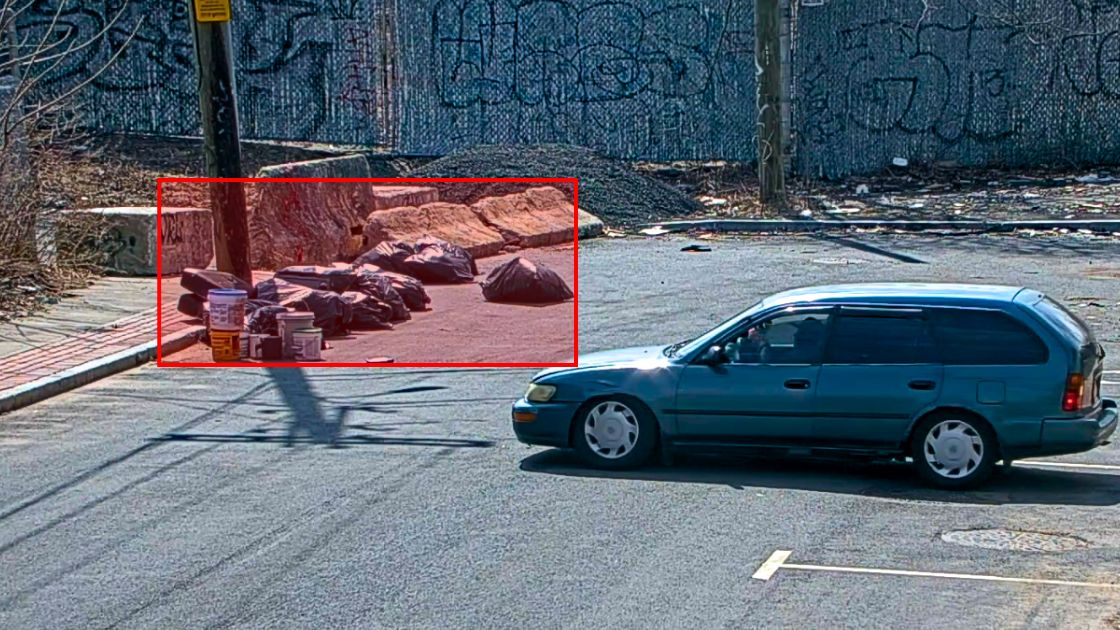In this article, you’ll learn how Milestone's XProtect video management software and BriefCam analytics work together with sensors to enhance situational awareness, support timely interventions and protect community well-being. We'll also explain how law enforcement agencies can secure funding for this kind of technology with the COPS grant.
Across the United States and beyond, drug-related activity continues to strain law enforcement resources, particularly in communities battling opioid and methamphetamine use. Historically, the response would be to get more boots on the ground and eyes on the street to deter crime. However, law enforcement knows they can’t be everywhere at once or be aware of every incident that occurs. For this reason, departments are looking for smarter, faster ways to detect activity in advance, gather evidence and intervene in time to save lives.
Video surveillance is a key to increasing situational awareness and achieving these goals, yet officers and analysts face massive volumes of video footage, limited access to certain spaces and increasing demand to do more with fewer resources.
That’s why integrating advanced video analytics and non-camera-based detection tools into real-time crime centers (RTCCs) is gaining traction. For instance, the combination of BriefCam video analytics and Triton Sensors’ radar and drug detection technology—both fully integrated with Milestone’s XProtect video management software (VMS)—offers a scalable and effective way to support anti-drug initiatives while also helping US-based law enforcement agencies qualify for COPS grant funding.
To help law enforcement agencies in the United States proactively address drug activity, the U.S. Department of Justice Office of Community Oriented Policing Services (COPS Office) offers a range of federal grants designed to fund the people, tools and strategies that make policing more effective and community focused. Not in the US? Consider researching similar grants in your country to support critical technology acquisitions.
COPS grants can be used to:
- Hire or rehire career law enforcement officers
- Implement community policing best practices
- Invest in technology and RTCC solutions
- Support anti-drug efforts through intelligence-led enforcement
Two of the most relevant funding opportunities for agencies tackling drug-related issues are COPS Anti-Methamphetamine Program (CAMP) and the Anti-Heroin Task Force (AHTF). CAMP supports state and local law enforcement in investigating methamphetamine production and distribution by providing the resources needed to carry out interdiction and enforcement operations. AHTF focuses on combatting the unlawful distribution of heroin, fentanyl and prescription opioids, offering support to multi-jurisdictional task forces that are on the front lines of the opioid crisis. Other notable COPS funding programs include the COPS Hiring Program (CHP) and the School Violence Prevention Program (SVPP), which can support broader public safety and technology initiatives.
Whether your agency is building out or scaling up existing infrastructure, COPS and other grants offer a tangible way to fund advanced technology like XProtect, BriefCam and sensors such as those from Triton and other Milestone technology partners. These tools can help reduce response times, gather actionable insights and ultimately improve public safety outcomes.
Now let’s take a closer look at how some of these security technologies help agencies reduce investigative workload, uncover patterns of illegal activity and respond more effectively to drug-related threats.
Whether you’re building a new RTCC or enhancing an existing deployment, video analytics is not only crucial to alleviating video review fatigue, but also enhances the ability to identify patterns, build cases and secure warrants quickly. Traditional video forensics require operators to manually review hours of footage with limited context, i.e. approximate timestamps or motion-triggered events. This process of mining meaningful data from video is not only time-consuming but mentally exhausting. Studies show that vigilance—the ability to maintain focus—begins to erode within just 20 to 30 minutes of continuous monitoring. The result? Significant drops in detection accuracy, missed evidence, slower investigations and a higher risk of operator burnout.
That’s where BriefCam comes in. As one of the most advanced and comprehensive video analytics solutions available today, BriefCam accelerates video review by transforming hours of footage into searchable, actionable data. Instead of officers spending hours, or even days, surveilling a suspected drug house, BriefCam enables you to filter by object, time, movement, appearance and dwell time to uncover patterns in minutes or even seconds.
In one example from the Hartford Police Department, a pole camera was installed to identify a suspected drug house. A pole camera is a durable, high-definition camera system built to watch over public spaces. Whether mounted on a utility pole, light pole, custom mast or in a hidden camera enclosure, it’s made for flexible deployment in high-crime areas, offering reliable, round-the-clock surveillance. A department analyst used BriefCam to process that footage, reducing 12 hours of video to just 16 minutes, allowing investigators to:
- Tag and trace every individual who entered and exited the property
- Create heatmaps to visualize high-traffic areas and pathways
- Apply filters to isolate people loitering, repeat visitors or individuals matching a description
- Generate reports with timestamps and imagery to support obtaining search warrants or building strong prosecution cases
BriefCam’s appearance similarity feature also played a critical role in this case. Instead of relying on face recognition—which is not available in certain situations and environments—appearance similarity analyzes an individual’s visual attributes, such as clothing, accessories and general physical features. Analysts use these filters to tag the anonymous image of a person in one video frame and instantly find all of their matching appearances across hours of footage, dramatically accelerating the investigative process. As more examples are tagged, the system becomes more accurate, helping analysts follow suspects across multiple scenes without relying on any of their biometric data.
Using this feature, Hartford PD was able to verify repeat visits to the drug house, track movements across multiple timestamps and confidently secure a warrant. Ultimately, they shut down two active drug houses located just one block away from a middle school. Watch the video below to see the process in the BriefCam platform:
BriefCam has a long-standing track record of supporting law enforcement investigations at every level—from local narcotics cases to major national incidents. Notably, the technology played a role in the investigation of the 2013 Boston Marathon bombing, helping law enforcement rapidly analyze hours of surveillance footage to identify key visual patterns. Its ability to accelerate video review, surface critical insights and support timely evidence gathering makes it a trusted solution for agencies tackling complex challenges, including drug-related crime.
While BriefCam excels in analyzing visual data, many drug-related incidents occur in spaces where cameras can’t go like locker rooms or restrooms. That’s where sensors, like those from Milestone’s technology partners, come in.
For instance, some sensors offer radar-powered capabilities that track movement, dwell time and air quality without collecting any personally identifiable information. This is crucial for agencies operating under privacy regulations while still needing full situational awareness.
Using radar that detects heartbeats and chemical sensors, these sensors can:
- Detect marijuana, meth and vape emissions
- Identify overoccupancy or extended dwell time, which can indicate potential overdose risk
- Alert operators to loitering or suspicious activity
- Provide occupancy visualization in real time using colored dots to indicate duration of occupancy
One of our technology partners, Triton Sensors, explained how these sensors have been deployed at a gas station chain struggling with instances of meth use in restrooms. Meth fumes can contaminate HVAC systems and drywall which require expensive remediation. They saw a 70% reduction in incidents after installing the sensors because they could intervene in real-time.
Some major international metro systems have had similar problems in their restrooms. By pairing BriefCam’s ability to monitor public areas outside of the restroom with sensor technology that alerts when someone stays in the restroom for too long and stops moving, operators can proactively intervene and save lives.
When it comes to managing multiple technologies in a real-time crime center, integration is everything. Without a unified interface, video footage, sensor data and alerts remain in silos, forcing analysts to jump between systems, manually sync timelines and piece together critical information under pressure.
XProtect, Milestone’s video management software, is the interface solving these problems by providing a centralized, flexible platform that brings your technologies together. BriefCam analytics and the technology available through Milestone’s extensive list of partners can be fully integrated with XProtect so agencies can manage video streams, sensor data and analytics in one cohesive interface. This means fewer screens to monitor, faster incident response and easier evidence gathering.
For instance, alerts from Triton Sensors—such as loitering, overoccupancy or drug detection—can appear alongside BriefCam, allowing operators to validate events as they occur and respond with confidence. In XProtect, each IoT sensor feed is treated like a video stream, making them all bookmarkable, searchable and exportable. Events can be configured to trigger custom actions, such as dispatching an officer, sending an alert to a supervisor or activating a speaker system.
XProtect also integrates seamlessly with other technologies, including:
- License plate recognition (LPR)
- Body-worn and in-vehicle cameras
- Access control systems
- Gunshot detection
- AI-based alerts from third-party analytics
- Drone camera feeds
For agencies looking to scale over time, the open platform ensures that today’s investment continues to deliver value tomorrow. Whether you’re adding cameras, deploying new sensors or expanding coverage to more facilities, XProtect grows with your needs—without locking you into proprietary tools. Discover more of Milestone’s technology partners using our Technology Partner Finder.
Most law enforcement agencies understand the need for advanced tech but funding is a massive hurdle.
Fortunately, as mentioned earlier, the U.S. Department of Justice’s COPS Office offers several grant programs specifically aimed at anti-drug initiatives and technology enablement for US-based law enforcement agencies.
Here’s how to get started:
- Register with SAM.gov - Obtain a Unique Entity Identifier (UEI): Your agency must have an active registration with the System for Award Management
- Register at Grants.gov – Make sure your agency is eligible and has at least two staff members enrolled.
- Apply through JustGrants.gov – Use the sample language and templates provided during this webinar to streamline the application.
- Submit before the deadline – These grants are typically due in late summer and awarded in September.
Milestone can provide sample grant language to help agencies describe their intended deployment and training protocols. Find more information here: https://cops.usdoj.gov/grants Additionally, if you feel that you need additional support through the grant application process, consider contacting a consulting service like EMD NYC to speak with them about their security grant services.
If you’re not in the United States, check with your governmental authorities to find out more about grant details for your region.


